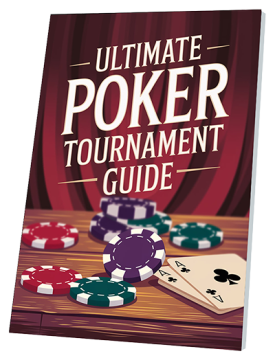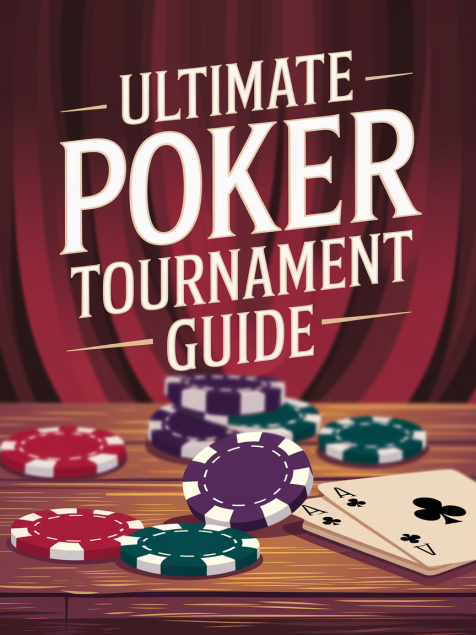FREE RESOURCE: Downloadable Poker Tournament Guide
🔥 Master the Tournament Grind and Win More Final Tables
Download the Ultimate Tournament Guide from 2x WPT Champion Jonathan Little

Want to win more money in tournaments? Download this free guide and learn the exact strategies 2x WPT Champion Jonathan Little uses to crush the final table.
Inside, you'll discover:
- Proven strategies to avoid early bust-outs and survive deep into the money.
- The mindset shift that separates pros from frustrated amateurs.
- The most common postflop mistakes—and how to exploit them.
- When to play aggressively and when to focus on survival.
- Final table tactics used by elite players to lock up five- and six-figure scores.
Understand how prize pool pressure changes your decision-making.
Know what hands to open, 3-bet, or fold in any situation.
Stay sharp and play your A-game deep into long sessions.
Learn from your mistakes and plug costly leaks in your game.
Simplify your decisions with easy-to-follow visual aids.
Learn the same strategies used by WPT champions and high rollers.
Download This FREE Guide from Jonathan Little and Start Crushing Tournaments Today
Poker tournaments are one of the most exciting and challenging formats of the game. Every hand presents a new decision point, every stage of the tournament brings shifting dynamics, and every player across the table is a puzzle waiting to be solved.
Over the past two decades, I’ve played thousands of live and online tournaments at every stake imaginable— burning out early, winning major events, and everything in between. Through those experiences, I’ve learned one thing: consistent success does not come from gimmicks or gut feelings. It comes from strategy, discipline, and constantly improving your decision-making process.
This guide distills what I’ve learned into a practical, easy-to-follow format. Whether you are just starting out or looking to sharpen your edge for the next big score, you will find strategies here to elevate your tournament game
Step #1. Preflop Strategy & Range Configuration
Preflop play sets the foundation for the rest of the hand. Mastering your open-raising and response ranges is one of the fastest ways to increase your win rate.
Therefore, we will start by breaking down opening ranges for different stack depths and dive into more details:
- Optimal opening ranges by position
- When to 3-bet light vs. flat call
- Big blind defense strategy based on stack depth
- How to exploit different raise sizes and player types
Step #2. C-Betting & Postflop Execution
Learn when to continue barreling and when to stop the aggression with flowcharts that simplify even the most complicated spots. Discover how to:
- Choose your c-bet sizing based on board texture
- Apply pressure with turn probes after missed flops
- Exploit opponents who overfold or “float” too often
- Use position and range advantage to control pots
Step #3. Flowcharts for Real-Time Decision Making
Poker is complex, but your decisions don’t have to be. These flowcharts give you a clear roadmap for high-pressure spots. If you are tired of second-guessing your decisions, get access to visual trees that help you:
- Respond to c-bets confidently
- Know when to turn probe or double barrel
- Build +EV river bluffs
- Decide when to call down with marginal hands
- Adapt based on stack sizes, position, and board texture
Step #4. ICM and Final Table Strategy
The Independent Chip Model (ICM) is a mathematical framework used in poker tournaments to assign a real-money value to each player’s chip stack. Understanding and applying ICM principles is crucial for making informed decisions, especially in the later stages of tournaments where prize money differences are significant. We’ll break down:
- ICM fundamentals: what they are and how to use them
- How to play differently near the bubble and at the final table
- Stack-size adjustments: big stack, mid stack, short stack
- When to apply pressure—and when to tighten up
Step #5. Exploiting Different Player Types
Recognizing opponent tendencies and making adjustments is one of the biggest edges in tournament poker. This section breaks down common player types and how to counter them:
- How to adjust vs. LAGs, TAGs, Nits, Fish, and Rec players
- Which strategies are most effective against different player profiles
- When to trap, when to bluff, and when to value bet thin
Step #6. Mindset, Preparation & Post-Session Review
Poker is as much about psychology as it is about math and strategy. The best players don’t just play the cards—they play the players. And before they do that, they master themselves.
Maintaining a strategic mindset over emotional reactions is essential for long-term success in poker. By focusing on making optimal decisions rather than being swayed by the outcomes of individual hands, players can improve their performance and resilience. You’ll learn how to:
- Stay emotionally detached from outcomes
- Build routines to improve focus and stamina
- Objectively review hands (even wins!) to identify leaks
- Use study tools and discussions to keep leveling up
Step #7. Bankroll Management & Long-Term Growth
Effective bankroll management is crucial for poker players aiming to progress beyond small stakes, as it ensures the ability to handle variance and minimizes the risk of going broke. By maintaining a dedicated poker bankroll and adhering to disciplined financial practices, players can steadily move up in stakes and achieve long-term success.
- A dedicated bankroll strategy for tournaments
- Guidelines for moving up or down in stakes
- Tools to handle variance like a pro
- Insights on game selection, rake, and volume goals
